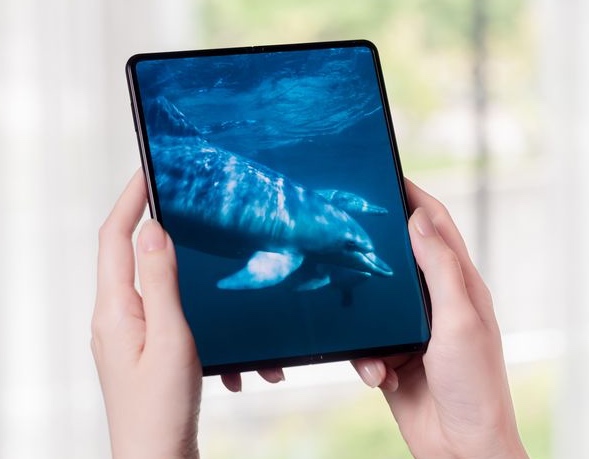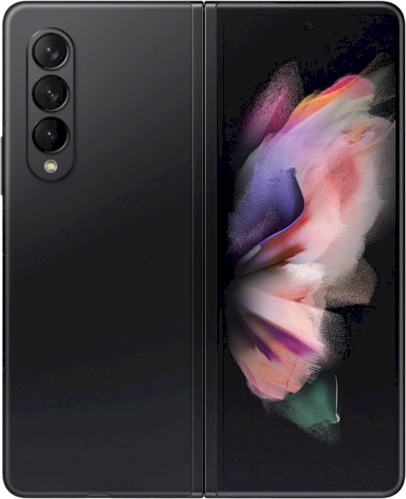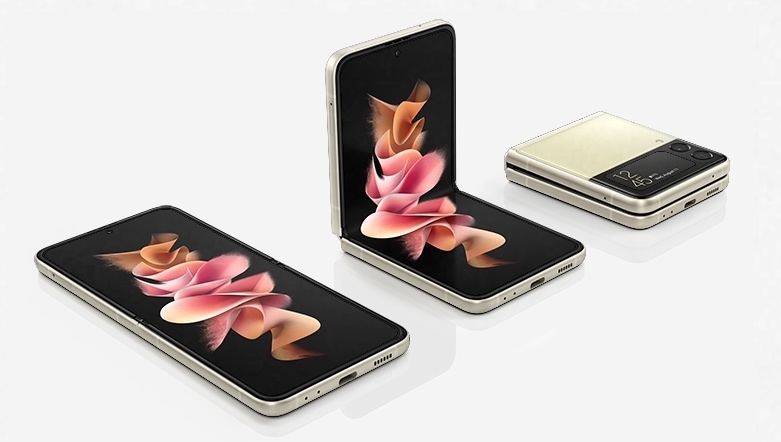When you're dealing with multiple things, each with multiple attributes, a table is often helpful to lay things out, so here goes. Here are the main four smartphone folding designs (excluding those we've seen as prototypes only, for example LG's attempt at a screen that 'unrolls'):
| Design type | Device examples |
Advantages, disadvantages |
| Flexible display, facing inwards, folding around vertical hinge, plus external full size 'cover display' |
Samsung Galaxy Z Fold 1 (2019), Z Fold 2 (2020), Z Fold 3 (2021) OPPO Find N |
Use as a tablet is almost seamless, with display pixels across the hinge. You can see and feel the crease. The external display is both an advantage (since it's there) and a disadvantage, since there's a whole extra screen to spec and pay for, in part explaining the typical price. |
| Flexible display, facing outwards, folding around vertical hinge | Huawei Mate X (2019), Mate XS (2020) | Use as a tablet is almost seamless, with display pixels across the hinge, and the crease is minimal, since the radius of curvature is much higher than on the type above (inwards folding). The obvious and huge disadvantage is that the relatively fragile flexible display is always exposed and often in contact with surfaces. |
| Flexible display, facing inwards, folding around horizontal hinge, plus external small notification and quick action display |
Samsung Galaxy Z Flip 1 (2019), Z Flip 2 (2020), Z Flip 3 (2021), Motorola RAZR, Huawei P50 Pocket | Here the phone folds in two to become half the plan size. You do gain a smaller footprint in the pocket, but it's twice the thickness of a regular phone when folded, obviously. As with the first folding type, there's a visible crease that you can feel, too. This folding type seems more popular, mainly because the units are the cheapest here. |
| Dual glass displays, folding around vertical hinge through 360º | Microsoft Surface Duo (2020), Duo 2 (2021) | The advantage of using two displays is that they can both be Gorilla Glass Victus (etc) and so relatively tough when exposed, plus they feel 'normal', as on any other oleophobic glass screen. The 'backs' of each device half could be tough plastic, though Microsoft went with more glass, for a premium feel when folded closed, at the expense of durability. The obvious disadvantage is that the 'hinge gap' between the two displays presents as a narrow black bar when using apps 'full screen' or watching media. |
It should be noted that none of these designs are really water or dustproof - the mechanics of a hinge make that impractical, especially as the device wears and 'loosens up'. The Samsung Z Fold 3 and Z Flip 3 achieve an IPX8 rating by nano-coating the electronics, but everything else foldable is very vulnerable to both dust and water. No doubt Microsoft, Oppo, Huawei, and others will head down the nano-coating route too, though this still doesn't completely solve the issue of dust working its way into the mechanical hinges.

In terms of use, in a previous LOI, I'd said, referring to an episode of the 361 Degrees podcast (Rafe and the gang), and talking about compromises in usability for Galaxy Z Fold range:
- When thinking about text entry, the external screen is overly narrow and restrictive, and the internal large flexible screen makes thumb typing awkward. We've become so use to fast and intuitive auto-corrected thumb typing on capacitive touch on glass that anything larger or smaller puts up barriers. Or at the very least having to re-train your hands and brain to work differently.
- For 'normal' phone use (social networks, for example), most third party applications aren't optimised for such a 'large' phone UI, resulting in wasted space and - again - awkward gestures and controls.
- Playing typical 18:9 media is thoroughly wasteful on the form factor, since the outer screen is roughly the right shape but too small, while the inner tablet display is the wrong aspect ratio. On the latter, the needed black bars top and bottom result in a useable video image - with a crease or gap in the middle - that's no larger than on a traditional 6.5"/6.8" display smartphone - which has no compromises and no crease or gap!
(Do subscribe to the 361 Degrees podcast, it's always a fun listen.)
I stand by all of this. Entering text (even casually, e.g. in social apps) and watching media are big parts of my day to day smartphone life and these are most definitely still compromised, even if (arguably) balanced by the advantages of a larger (and/or split) screen-set.
However, as per the article title, assuming that the usability gripes here don't put you off and that you're considering the four folding 'types' above, is there a winner? Is there a 'best design'? Where should you start?
I've reviewed (or at least played with) most of the devices listed in the table and the only one I even considered putting down my own money for is the Surface Duo 2, but it's not trivial to explain why.
You see, the Samsung Galaxy Z Fold range is, inherently, the most useable, since its tablet mode isn't broken up by a 'gap' and since you can use it just as easily when closed, thanks to the extra cover display. Albeit at extra cost, if you want maximum screen space more of the time then the Z Fold 3 is the obvious choice. And, as noted, it's even waterproof to an extent now.
But I do worry. Flex material 50 times every day, week on week, month on month, under real world conditions, and something will break. Whatever Samsung claim under their factory test conditions. My first hands-on with the Z Fold range was (friend of the site) Matt Miller's personal unit and he's upgraded each year, with his latest Z Fold 3 display failing on him recently. Admittedly Samsung were good about the warranty repair, but still there was something of an inevitability about the need for repair in the first place.

But it's more than that - after all, it's easy enough to factor in a screen repair every few years (if under a warranty). There's something... inelegant about needing that extra cover display at all. The whole raison d'etre of the Galaxy Z Fold range is the internal, large, folding display and yet half the time you'll be using the traditional single screen on the outside, the panel that shouldn't really even be needed. The irony is that when the Z Fold 2 and then 3 came out, people applauded the use of even larger cover displays, yet I'd have been happier with just a token, tiny screen for notifications, so that almost all the time you had to open the device out and use its Unique Selling Point!
But maybe this is just me. Attitudes to new tech like folding phones are always going to be subjective.
Now the Z Flip range (which I got to review formally here) does use a small cover display so that, yes, you are encouraged to 'flip' the device open all the time. That's the spirit. Except that even when unfolded, you're still dealing with a traditional candybar touchscreen phone, so you haven't gained anything much, and then you live with something small and chunky when in the pocket. I just don't get it.

I'll draw a veil over the preposterous Huawei design, since a system where all the most fragile material is on the outside all the time is never going to be a good idea - then add in the exorbitant price, almost designed to put people off. AND there are the usual frustrations about Huawei not being allowed to use Google apps and services anymore.
All of which leaves... the Microsoft Surface Duo 2. As I said in my full review, with only one caveat (the camera bump preventing a true 360 folding action), Microsoft has got almost everything right. Quite deliberately and specifically, you're forced to open the Duo (or leave it open) in order to actually do anything, meaning that you're using the unique double hinge and two displays almost all the time. Which somehow seems more efficient to me.
The hinge gap is smaller than on the original Duo, there's the potentially interesting glance bar when the device is fully closed, super diagonally opposed stereo speakers, decent triple camera, and so on.

Having two traditional super-smooth glass displays to work on rather than depressable plastic is lovely. Many applications either span the hinge gap or present a two-paned interface, as needed. So not quite as flexible as on the likes of the Z Fold 3 but in practice it's not far off. Of course, if you span media (e.g. watching YouTube), then you have to live with the hinge gap down the middle of the video frame - it's actually not too bad, in practice (it's amazing what the brain gets used to!)
Then, when you want to use the Duo 2 as a regular candybar smartphone, fold the other display back underneath and you're using the other main screen, not (as on the Z Fold 3) an extra screen, shoehorned in for the purpose. Note the software enhancements last week to ensure this single screen assignment happens properly every time.

So... I contend that the Surface Duo 2 (née Surface Phone, née Andromeda) is currently the most interesting and desirable folding smartphone as we go into 2022. It's the right call in terms of design and engineering elegance.
But, as ever, your comments welcomed!
